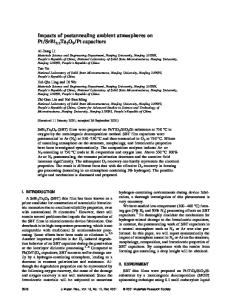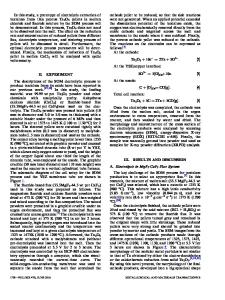Study Of Ta 2 O 5 Based MOS Capacitors, With Tantalum Oxidized In O 2 :NH 3 Ambient.
- PDF / 157,529 Bytes
- 6 Pages / 612 x 792 pts (letter) Page_size
- 38 Downloads / 272 Views
Study Of Ta2O5 Based MOS Capacitors, With Tantalum Oxidized In O2:NH3 Ambient. Pallavi Krishnamoorthi and A N Chandorkar, Dept of Electrical Engineering, IIT Bombay, Powai, Mumbai, INDIA. 400 076 ABSTRACT Tantalum Pentaoxide, an alternative to SiO2, as a high-k dielectric for DRAM and MOS applications, faces the problem of interface mismatch at silicon. SiO2 or Si3N4 interfacial layer could help in overcoming this problem. The higher band offsets of these materials also help in the reduction of leakage currents at low electric fields. Here we study the physical and electrical characteristics of Ta, oxidized in O2:NH3 ambient, and without any other interface layer. This is done to check if N/H moves to the interface, and thus improves the electrical properties. XRD studies of the film, showed the presence of Ta2O5. Peaks corresponding to TaSi2, un-oxidized tantalum and TaN were also found in the film. But the intensity of these peaks decreased with the reduction of NH3 content. Thus a higher oxygen content could reduce the content of TaN and unoxidized tantalum. FTIR analysis however showed strong Ta=O and Si-O peaks. For the MOS capacitors, due to the presence of resistive components, the maximum capacitance was reduced, compared to that of pure Ta2O5 films. Oxide charges in the films were observed to be around 1.9E10 cm-2. But the traps in these films were found to be almost negligible as observed from the negligible hysteresis in the C-V characteristics. Films with N/H showed lesser oxide charges by an order of magnitude, as compared to pure Ta2O5 films. INTRODUCTION Astounding progress has been made in Silicon technology, achieved through continual scaling of semiconductor devices to smaller dimensions. Miniaturization, apart from device area includes also the gate oxide thickness reduction. The thickness reduction of SiO2 is limited to a certain value, which depends on the leakage current limits, penetration of dopants from one electrode to another in a MOS capacitor and the uniformity limits which can be achieved while deposition of the dielectric. To overcome these limitations, a physically thicker dielectric could help and a highdielectric constant material helps serve the purpose. Various high-k dielectrics have been studied by researchers, like Al2O3, TiO2, ZrO2, HfO2 and BST. Ta2O5 , due to its high dielectric constant of 25-60, and also due to good dielectric relaxation constant, which is very essential for memories, has already been used in DRAMs. [1] The problems reported for use of Ta2O5 in MOSFETs, has been the growth of SiO2 layer during Ta2O5 deposition or post-oxidation annealing. P. Gallais et al. have reported that Ta forms TaSix for temperatures greater than 600oC [2], which acts as a good interfacial layer. Ta+SiO2 -----> TaSix + TaOy (at temp > 600oC)
(1)
B11.15.1 Downloaded from https:/www.cambridge.org/core. University of Arizona, on 21 Apr 2017 at 05:07:05, subject to the Cambridge Core terms of use, available at https:/www.cambridge.org/core/terms. https://doi.org/10.1557/PROC-716-B11.15
Data Loading...











